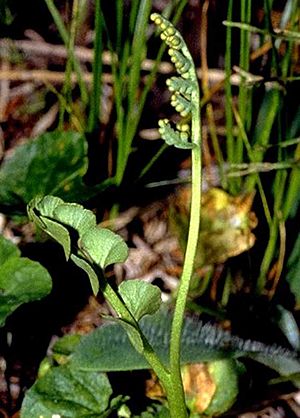Ophioglossidae facts for kids
Quick facts for kids Ophioglossidae |
|
|---|---|
 |
|
| Botrychium lunaria | |
| Scientific classification |
|
| Kingdom: | Plantae |
| Clade: | Tracheophytes |
| Class: | Polypodiopsida |
| Subclass: | Ophioglossidae Klinge 1882 |
| Type genus | |
| Ophioglossum |
|
| Orders | |
|
|
| Synonyms | |
|
|
Ophioglossidae is one of the four subclasses of Polypodiopsida (ferns). This subclass consists of the ferns commonly known as whisk ferns, grape ferns, adder's-tongues and moonworts. It is equivalent to the class Psilotopsida in previous treatments, including Smith et al. (2006). The subclass contains two orders, Psilotales and Ophioglossales, whose relationship was only confirmed by molecular phylogenetic studies.
Taxonomy
Smith et al. (2006) carried out the first higher-level pteridophyte classification published in the molecular phylogenetic era, and considered the ferns (monilophytes), with four classes. They placed the whisk ferns and related taxa in the class Psilotopsida, with two orders. Mark W. Chase and James L. Reveal (2009) classified them as two separate subclasses, Psilotidae and Ophioglossidae, corresponding to those orders within a much broader grouping, the class Equisetopsida sensu lato. Christenhusz et al., 2011, included both the Ophioglossales and Psilotales orders in the Ophioglossidae subclass. This was continued by both Christenhusz and Chase (2014) and by the Pteridophyte Phylogeny Group (2016). Under the latter the subclass is one of four subclasses of Polypodiopsida (ferns) and contains two orders, two families, 12 genera, and an estimated 129 species. The relationships between the two orders, Psilotales and Ophioglossales, has long been unclear and was only confirmed by molecular systematic studies. Psilotales have rhizoids instead of real roots, and the roots in Ophioglossales are lacking both root branches and root hairs. The gametophytes of both orders are heterotrophic and often subterranean, getting nutrients from mycorrhiza instead of performing photosynthesis, which happens exclusively in the sporophyte.
The following cladogram shows a likely phylogenic relationship between subclass Ophioglossidae and the other Polypodiopsida subclasses. The first three small subclasses are sometimes informally referred to as eusporangiate ferns, in contrast to the largest subclass, Polypodiidae or leptosporangiate ferns.
| Polypodiopsida |
|
||||||||||||||||||
The two orders, Ophioglossales and Psilotales are sister groups to each other.
See also
 In Spanish: Ophioglossidae para niños
In Spanish: Ophioglossidae para niños

